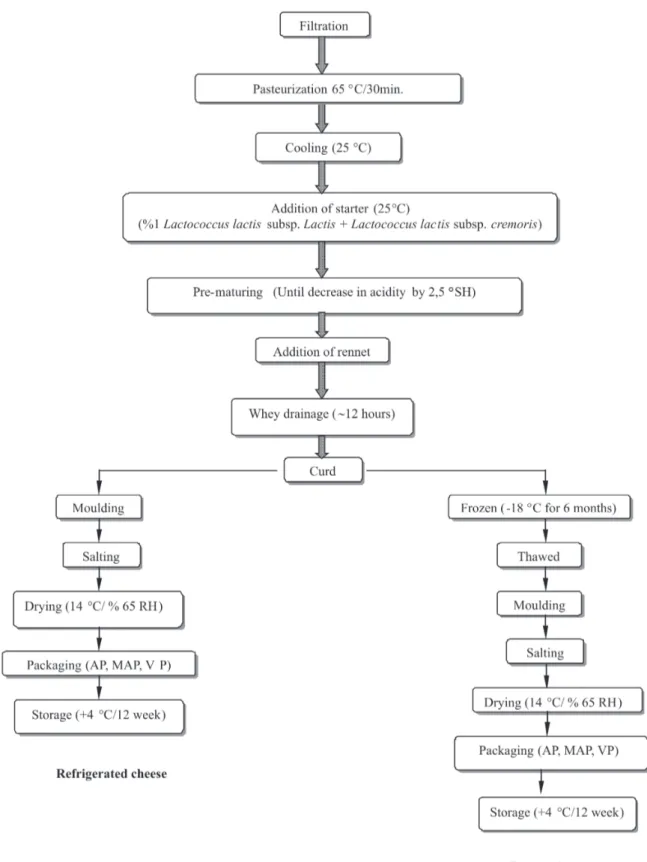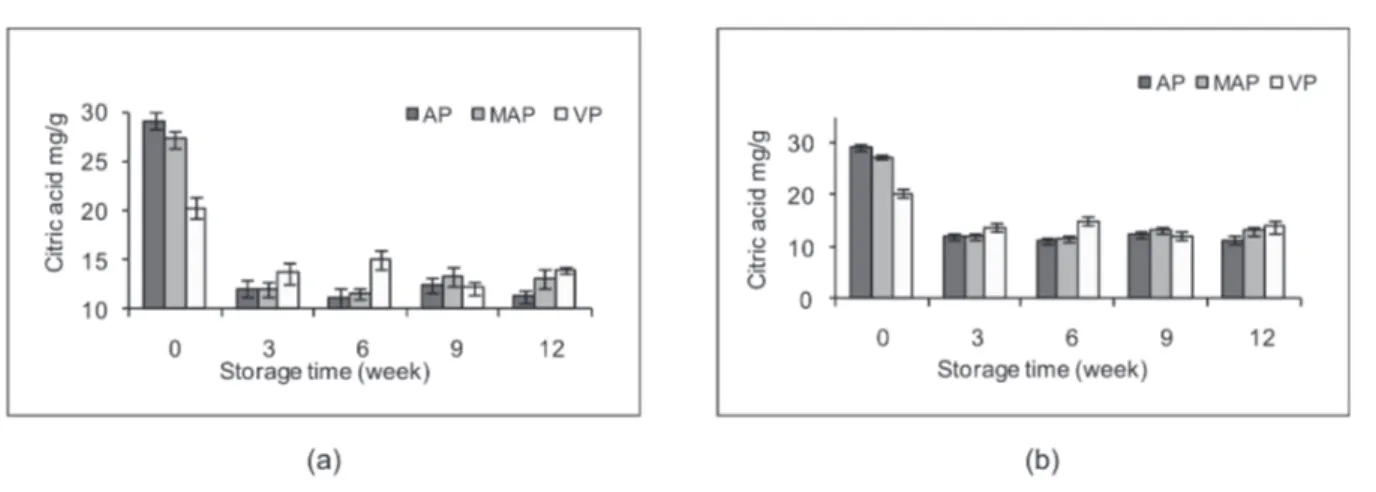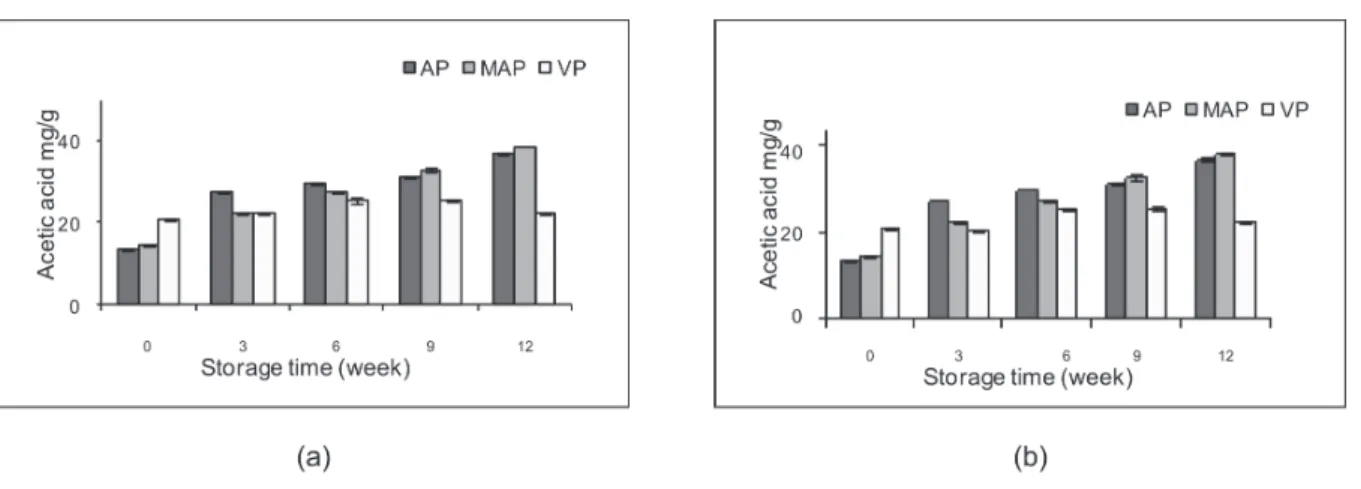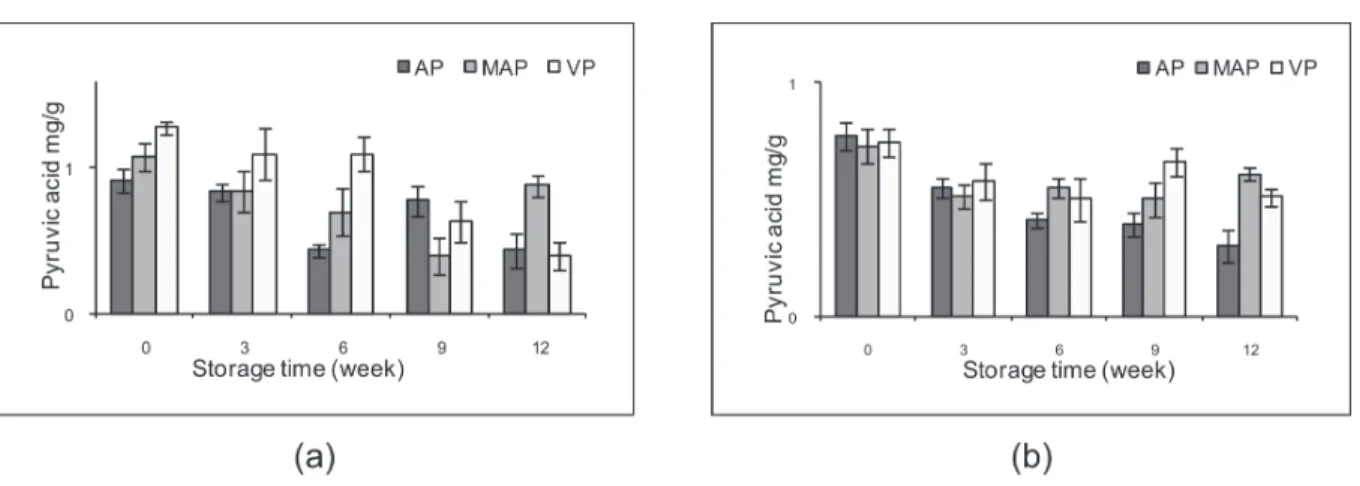Original scientific paper - Izvorni znanstveni rad UDK: 637.3.05
Effect of curd freezing and packaging methods on the
organic acid contents of goat cheeses during storage
*Corresponding author/Dopisni autor: Phone/Tel.: +90 532 7087039; E-mail: pelingunc81@hotmail.com
A. Kemal Seçkin1, Özlem Kizilirmak Esmer2,
Pınar Balkir3, Pelin Günç Ergönül1*
1Celal Bayar University Faculty of Engineering Food Engineering
Department Muradiye, Manisa, Turkey
2Ege University Faculty of Engineering Food Engineering
Department Bornova, İzmir, Turkey
3Ege University Technical and Business College Bornova, İzmir, Turkey
Received - Prispjelo: 23.12.2010. Accepted - Prihvaćeno: 19.07.2011.
Summary
Effects of freezing and packaging methods on organic acid content of goat cheese during 12 weeks of storage were determined. Goat cheese milk curds were divided into two batches; one of the batches was directly processed in to goat cheese while the other was frozen at -18 °C and stored for six months and processed into cheese after being thawed. Cheese samples were packed in three parts and stored at 4 °C refrigerated control sample and at -18 °C for six months frozen experimental samples. Cheese samples were packed in three different packaging methods: aerobic, vacuum or modified atmosphere. Citric, malic, fumaric, acetic, lactic, pyruvic and propionic acids were analyzed using HPLC method after 1st, 3rd, 6th, 9th and 12th week of storage period. Lactic acid was the main
organic acids while pyruvic acid had the lowest content in all cheese samples. Citric and fumaric acid levels of frozen samples increased during storage whereas malic, acetic, pyruvic and propionic acid amounts were decreased compared to the beginning of storage. Packaging methods and freezing process also effected lactic acid levels statistically (p<0.05). Fumaric, acetic and lactic acid concen-tration of refrigerated samples were increased but citric, malic and propionic acids decreased during storage. Pyruvic acid level did not change significantly. It was determined that organic acid concentra-tions were effected by freezing process, storage time and packaging methods significantly (p<0.05).
Key words: organic acids, goat cheese, freezing, packaging Introduction
Organic acids occur in dairy products as a re-sult of normal animal metabolism and break down of milk protein, fat, lactose and citrate during manu-facture and storage. They play important role in the flavor of dairy products and so, they contribute to cheese quality (Califano and Bevilacqua, 1999). Many researchers use the level of some organic acids as indicator of starter activity and bacterial growth during cheese ripening (Careri et al, 1996). Organic acids can reflect the kind of fermentation and indi-cate deviations of the expected course of maturation, potentially leading to defects (Careri et al, 1996;
de Llano et al., 1996). The organic acid profile was found to differ among cheese varieties and some or-ganic acids are of importance for the typical flavor of some cheeses (Manolahi et al., 2006) as acetic acid is a major contributor to the flavor of Feta cheese (Abd El-Salam and Alichanidis, 2004). The level of individual organic acid was found to vary accord-ing to the processaccord-ing procedure, the ripenaccord-ing tem-perature and duration, the production season and type of a starter (Skeie, Linberg and Narvhus, 2001). Freezing is a suitable procedure to prolong stability and shelf-life of cheeses although some au-thors pointed out the lack of unanimity on the ex-tent of damage caused by freezing. Damage depends
a large ice crystal formation in the ovine milk frozen at -15 °C compared to -27 °C.
Modified atmosphere packaging (MAP) and vacuum packaging (VP) can be used to increase the shelf life of cheeses. Shelf life of unpacked fresh cheese changes according to type of cheese and storage temperature. Generally they are no more than 10-12 days at refrigerator temperature be-cause of the effect of O2 on microbial growth and sensory characteristics. The potential of MAP and VP for extending the shelf-life of cheese has been demonstrated by various researchers (Favati et al., 2007; Oliszewski et al., 2007; Papaioannou et al., 2007). Numerous varieties of goat milk cheeses are produced word wide and goat milk cheese has recently gained popularity among many consumer groups and farmers in the world (Park and Jin, 1998). Very few studies have been conducted on storage stability of goat milk cheeses and freezing process and packaging method in relation to organic acid contents. Thus, aims of this study were to de-termine organic acid profiles of plain goat cheeses, to compare changes in organic acids content of fresh and frozen-thawed plain soft goat cheeses and to evaluate and to compare the effect of storage on or-ganic contents of freezing and refrigerated storage cheeses.
Materials and method
Cheese making procedure
Cheese productions were carried out at the pilot plant of Pınar Dairy Products Inc (İzmir, Turkey). The manufacturing procedure of acid goat cheese is as described in Figure 1.
properties is required. In this film combinations, EVOH functioned as a barrier layer. It was used for MAP application 20 % CO2 and 80 % N2 as it is the combination of soft cheese. And as a control, aerobic air packaging (AP) is also applied. These packagings are used in dairy industry widely.
Experimental design
After production of two batches of experimen-tal cheese curd (frozen at -18 °C for six months and refrigerated at 4 °C for 12 weeks), organic acid com-positions of cheeses were determined and the batch was divided into 3 groups for VP, for MAP and for aerobic packaging (AP). These groups were stored at +4 °C for 12 weeks. Organic acid analyses were performed after 1st, 3rd, 6th, 9th and 12th weeks of
storage. Productions were done in triplicate. At each analyses period three different packed cheeses were analyzed and analyses were done in duplicate.
Organic acid determination
Extraction of organic acids
Organic acids were determined according to Buffa et al. (2004). Seven grams of goat cheese was taken and than 40 ml mobile phase (0.1 % H3PO4) was added and mixed by ultraturrax for 1 minute. Mixture was held in water bath (40 °C) for 1 hour, than centrifuged at 6000 rpm for 5 minutes. Upper phase was filtered through filter paper (Whatman No.1).
A Perkin Elmer Series 200 Model HPLC appa-ratus equipped with a UV absorbance detector set at 214 nm was used. Chromatographic separation was performed on a Shodex RSpak KC-118 model ion-exchange organic acid column (8x300 mm i.d.). The mobile phases was 0.1 %(w/v) of phosphoric acid in distilled water (HPLC grade) with a flow rate of 0.8 mL/min.
Statistical analyses
The treatment structure was completely rand-omized design. The analysis of variance was carried using the PROC GLM procedure of SAS (version 8.2, SAS Institute, Cary, NC, 2001). Least Squares of Means (LSMEANS) for treatments were gener-ated.
Results and discussion
Citrate in milk is metabolized by many lactic acid bacteria into flavor compounds such as acetate, acetaldehyde and diacetyl (Hugenholz, 1993). Citric acid level of refrigerated AP cheese was 29.22 mg/g at the beginning of storage. During the storage this level changed irregularly and at the end of rip-ening it decreased to 11.35 mg/g. At the beginning of storage, citric acid level of frozen AP sample was 12.84 mg/g while at the end of storage it was 14.67 mg/g cheese (Figure 2).
Storage process effected the citric acid level of frozen AP cheeses (p<0.05) while it did not effect refrigerated AP cheese (p>0.05). Freezing process effected the citric acid levels of AP samples statisti-cally (p<0.05). Citric acid content of refrigerated MAP samples changed during the storage significant-ly (p<0.05). Citric acid content reached maximum
maximum level at 12th week of storage as 13.93
mg/g for refrigerated VP cheese while frozen VP samples had maximum level at 6th week of storage as
11.95 mg/g (Figure 2). Packaging type also effected the citric acid concentration for frozen and refriger-ated cheeses. Citric acid level of refrigerrefriger-ated cheeses is higher than all of frozen samples. So, frozen proc-ess may effect the survival of Lactococcus sp., Leu-conostoc sp. and Lactobacilli sp. that are metabolized citrate. Monalaki et al. (2006) determined organic acid contents of Feta type cheese during the stor-age. They found that citric acid content of cheese was regularly decreased with storage time. Akalin et al. (2002) claimed that the citric acid contents of white cheese changed irregularly during the stor-age. But at the end of storage citric acid content in-creased compared to beginning level. These results are parallel with the results of Akalin et al (2002). Park and Lee (2006) researched freezing effect on organic acid content of goat milk cheese and they declared that citric acid content increased in frozen type while for refrigerated type cheese it decreased with storage. This result resembles with our results.
The highest malic acid levels of refrigerated and frozen AP were 32.36 and 21.15 mg/g respectively at the beginning of the storage. Malic acid level de-creased strictly to 20.05 mg/g at 3rd week for
re-frigerated AP samples, than increased to 21.60 mg/g and then decreased. At the end of storage malic acid level decreased to 15.21 mg/g (Figure 3). For frozen cheese, malic acid level decreased regularly until 6th
week and then increased slightly. At the end of stor-age malic acid level of AP was determined as 17.52 mg/g. At 1st week of storage the malic acid of MAP
refrigerated sample was 21.89 mg/g while at the end of storage this value decreased to 15.42 mg/g.
Figure 2. Citric acid change in refrigerated (a) and frozen (b) goat cheese
Figure 3. Malic acid change in refrigerated (a) and frozen (b) goat cheese
For frozen MAP cheese, malic acid decreased from 21.06 mg/g to 16.35 mg/g. Malic acid levels of MAP and AP refrigerated and frozen cheese decreased strictly at 3rd week from 21.89 and 21.06 to 15.92
and 14.81 mg/g cheese respectively and then both samples increased slightly. For VP refrigerated sam-ples, malic acid of cheeses were 21.07 and 21.08 mg/g respectively. For frozen and refrigerated VP samples, malic acid contents changed irregularly during the storage (Figure 3). Packaging method ef-fected malic acid samples for frozen and refrigerated cheeses importantly (p<0.05). Statistically, storage process also effected malic acid level of frozen and refrigerated cheese for all type of packaging samples (p<0.05). Malic acid level is affected by bacterial activity and this activity is effected by frozen and packaging process. So, these differences might origi-nate for this reason. For both samples (frozen and refrigerated) storage process effected the malic acid levels significantly for AP, MAP and VP samples (p<0.05). Park and Drake (2005) and Park and Lee (2006) found that malic acid content of refrig-erated goat cheese increase while it decreased for frozen goat cheese. Buffa et al. (2004) claimed that malic acid level increased very strictly during ripen-ing. In this study the malic acid concentration of fro-zen type of all cheese samples (AP, MAP and VP) increased, but for refrigerated cheese this was seen to be contrast. So, these results of frozen cheese re-semble with Park and Drake (2005) and Park and Lee (2006) and Buffa et al. (2004).
At the beginning of the storage, fumaric acid content of refrigerated and frozen AP, MAP and VP samples were 1.47, 1.34, 2.85, 1.14, 1.07 and 1.31
mg/g respectively. As it can be seen from Figure 4, generally at the end of storage fumaric acid con-centration of the samples increased with respect to beginning levels. The highest fumaric acid level of refrigerated AP reached at 3rd week as 3.08 mg/g.
For MAP and VP samples, the highest values were at 9th week 12st week of storage as 2.72 and 2.86 mg/g
respectively. For frozen AP samples, the highest val-ues were reached at 3thas 2.64 while for MAP and
VP samples were at 6th week of storage as 2.23 and
2.38 respectively. Statistically storage time, packag-ing type and freezpackag-ing process effected fumaric acid level of all cheese samples (p<0.05).
Acetic acid is considered as a product of se-veral biochemical pathways, such as fermentation of lactate and citrate or metabolism of amino acids by bacteria. It contributes greatly to the final flavor of cheese (Kandarakis et al., 2001). Acetic acid may provide an indication of the degree of heterof-ermentative metabolism that may have taken place in cheese (Bouzas et al., 1993). Acetic acid levels of frozen AP, MAP and VP were higher than refrig-erated samples. Acetic acid levels of frozen cheese samples showed irregularly changing. Until 3rd week
acetic acid levels were not changed importantly than increased at 6th week and then these levels
increased again at 9th week and at the end of
stor-age acetic acid levels decreased again. At 1st week
the amount of acetic acid levels of refrigerated AP, MAP and VP were 13.46, 14.35 and 20.76 mg/g at the beginning of storage and these levels were in-creased to 36.83, 38.14 and 22.33 mg/g at the end of storage. It can be said that acetic acid levels of refrigerated cheeses increased during the storage. Figure 5. Acetic acid change in refrigerated (a) and frozen (b) goat cheese
Figure 6. Pyruvic acid change of refrigerated (a) and frozen (b) goat cheese
Figure 7. Lactic acid change of refrigerated (a) and frozen (b) goat cheese
ated cheese samples while the results of Monolaki et al. (2006) and Park and Drake (2005) showed parallel results with these frozen cheese samples.
Pyruvic acid levels were at the lowest level among the other organic acid of the sample. At 1st
week of storage, the pyruvic acid level of refriger-ated AP cheese was 0.46 mg/g. This level did not change importantly until end of storage (Figure 6). The pyruvic acid level of MAP and VP samples were 0.54 and 0.64 mg/g at the beginning of stor-age. These amounts did not change importantly until 6th week of storage like AP. Statistically storage time
effected pyruvic acid concentration of refrigerated cheese samples (p<0.05). The pyruvic acid level of frozen cheeses packed in AP, MAP and VP were 0.77, 0.73, 0.74 mg/g respectively at the beginning of storage. These results are different from Buffa et al. (2004) and Manolaki et al. (2006) results. This difference could come from production and packag-ing methods.
Lactic acid levels were at the highest level com-pared to the amounts of other organic acids of goat cheese. As it can be seen from Figure 7, lactic acid levels of refrigerated cheese samples in AP, MAP and VP package, were 120.76, 104.58 and 147.29 mg/g, respectively. These values of frozen cheese in AP, MAP and VP package were 308.57, 296.98 and 294.76 mg/g respectively. The contents of lactic acid of refrigerated cheese samples packed in AP, MAP and VP slightly increased (p>0.05) during storage time and were 138.96, 133.54 and 154.04 mg/g, re-spectively at the end of storage. The frozen cheese samples in AP, MAP and VP differed by 196.43, 192.34 and 190.31 mg/g of lactic acid, respectively (Figure 7), while for frozen cheese showed the same status except 6th week of storage. For all samples,
the storage process effected lactic acid level
impor-the findings of Park and Drake (2005) and Kami-narides et al. (2007). For the frozen sample, it was observed that lactic acid concentration changed very slightly. Therefore, this result resembles to Buffa et al. (2004) results. Califano and Bevilacqua (1999) studied the effect of freezing process on changing organic acid content of Mozzarella cheese. They found that freezing process did not affect the lactic acid content of cheese. This result is different from the results of this research. In this study freez-ing affected the lactic acid concentration of all type of cheeses.
Propionic acid contents of frozen AP, MAP and VP samples were 21.90, 22.29 and 23.37 mg/g and 10.54, 9.37 and 11.09 mg/g of refrigerated cheese samples, respectively, after 1st week of storage
(Fig-ure 8). As it can be seen, propionic acid levels of frozen samples were 2-3 times higher than same of refrigerated cheeses. It was probably consumed by the microorganisms mainly during the period of their maximum propagation and activity (1-3 week). For both samples at 6th week, the propionic acid levels
were decreased strictly than increased again. Statis-tically storage time affected propionic acid levels of all samples. Packaging method and freezing process also affected these organic acid levels. Akalin et al. (2002) and Monolaki et al. (2006), Park and Lee (2006) claimed to increase propionic acid contents of cheese during ripening. So, these results are not resembled with results of this research. These dif-ferences can become from production and packaging methods.
Conclusions
Organic acids are very important for quality of cheese and they can be used as indicator of starter activity during ripening. In this study, seven differ-ent organic acids were determined in frozen and refrigerated samples during storage. Citric, malic, fumaric, acetic, propionic acid levels of all samples were affected significantly with freezing, packaging and storage time. For all samples pyruvic acid was the lowest organic acid whereas lactic acid was the highest. On the other hand lactic acid levels of the samples were not affected by storage period and freezing process.
Organic acids play important role in the fla-vor of dairy products and they can reflect the kind of fermentation. The results of study indicate that freezing goat cheeses would be feasible for later marketing which can overcome the seasonality of goat milk production and enhance the sustainability of the dairy goat industry.
Utjecaj zamrzavanja
i metoda ambalažiranja na udjel
organskih kiselina kozjeg sira tijekom
skladištenja
Sažetak
U istraživanju je utvrđen utjecaj zamrzavanja i metoda ambalažiranja na udjel organskih kiselina ko-zjeg sira tijekom 12 tjedana skladištenja. Gruš sira od kozjeg mlijeka bio je podijeljen u dva dijela - kao kontrolni uzorak pohranjen u hladnjaku na 4 °C i kao zamrznuti eksperimentalni uzorak na -18 °C tijekom šest mjeseci. Nakon toga, sirevi su pakirani trima različitim metodama pakiranja: aerobnom, vakuum ili modificiranom atmosferom. Citronska, jabučna, mravlja, octena, mliječna, pirogrožđana i propionska kiselina analizirane su HPLC metodom nakon 1., 3., 6., 9. i 12. tjedna razdoblja čuvanja. Mliječna kiselina bila je najvažnija organska kiselina, dok je pirogrožđa-na imala pirogrožđa-najniži udjel u svim uzorcima sira. Tijekom skladištenja došlo je do povećanja udjela citronske i mravlje kiseline smrznutih uzoraka, dok su udjeli jabučne, octene, pirogrožđane i propionske kiseline opadali u odnosu na početak pohrane. Metode
paki-ranja i proces zamrzavanja također su statistički utje-cali na udjel mliječne kiseline (p<0,05). Koncen-tracije mravlje, octene i mliječne kiseline ohlađenih uzoraka bile su povećane, dok su citronske, jabučne i propionske kiseline opadale tijekom skladištenja. Razina pirogrožđane kiseline nije se značajno promi-jenila. Utvrđen je statistički značajan utjecaj procesa zamrzavanja, vremena pohrane i metoda pakiranja na koncentracije organskih kiselina (p <0,05).
Ključne riječi: organske kiseline, kozji sir, zamrzavanje, pakiranje
References
1. Abd El-Salam, M.H., Alichanidis, E.: Cheese varieties ripened in brine (3rd ed. In P.F. Fox, P.L.H., McSweency
T.M. Logan and T.P. Guince) (2004): Cheese: Chemistry, Pyhsics and Microbiology, Amsterdam:Elsevier 2004; vol.2. pp. 227-249
2. Akalin, A.S., Gönç, S., Akbaş, Y. (2002): Variation in organic acid content during ripening of pickle white cheese. Journal of Dairy Science85, 1670-1676. 3. Bouzas, J., Kantt, C.A., Bodyfelt, F.W., Toress, J.A.
(1993): The and temperature influence on chemical ag-ing indicators for a commercial Cheddar cheese. Journal of Food Science 58, 1307-1331.
4. Buffa, M., Guamis, B., Saldo, J., Turijillo, A.J. (2004): Changes in organic acids during ripening of cheeses made from raw, pasteurised or high-pressure treated goats milk. Lebensm. Wiss. Tech37, 247-253.
5. Califano, A.N., Bevilacqua, A.E. (1999): Freezing low-moisture Mozzarella cheese: changes in organic acid con-tent. Food Chemistry 64(2), 193-198.
6. Careri, M., Spagroli, S., Panori, G., Zannoni, M., Barb-ieri, G. (1996): Chemical parameters of the non-volatile fraction of ripened Parmigiano-Reggiano Cheese. Inter-national Dairy Journal 6(2), 147-155.
7. Cervantes, M.A., Lund, D.B., Olson, M.F. (1983): Ef-fects of salt concentration and freezing on Mozzarella cheese texture. Journal of Dairy Science66, 204-213. 8. De Liano, D.G., Rodriguez, A., Cuesta, P. (1996): Effect
of lactic starter cultures on the organic acid composition of milk and cheese during ripening analysis by HPLC.
Journal of Applied Bacteriology 80(5), 570-576. 9. Diefes, H., A., Rizvi, S.S.H., Bartsh, J.A. (1993):
Rhe-ological behaviour of frozen and thawed low moisture part skim, Mozzarella cheese. Journal of Food Science58, 764-769.
10. Favati, F., Galgano, F., Paca, M. (2007): Shelf-life evaluation of portioned provolone cheese packed in protective atmosphere. Lebensmittel-Wissenschaft und Technologic(LWT)40, 480-488.
15. Oliszewski, R., Cisint, J.C., Nunez, de Kairuz, M. (2007): Manufacturing characteristics and shelf-life of Quesillo, an Argentinean traditional cheese. Food Con-trol18, 736-741.
16. Papaioannou, G., Chouliana, I., Karatapanis, A.E., Kon-taminas, M.G., Savvaidis, I.N. (2007): Shelf-life of a Greek whey cheese under modified atmosphere packag-ing. International Dairy Journal 17, 358-364.
21. Skeie, S., Lindberg, C., Narvhus, J. (2001): Develop-ment of amino acids and organic acids in Norvegia, influ-ence of milk treatment and adjunct Lactobacillus. Inter-national Dairy Journal11, 399-411.
22. Wendorff, W.L. (2001): Freezing qualities of raw ovine milk for further processing. Journal of Dairy Science84, E74-E78.



